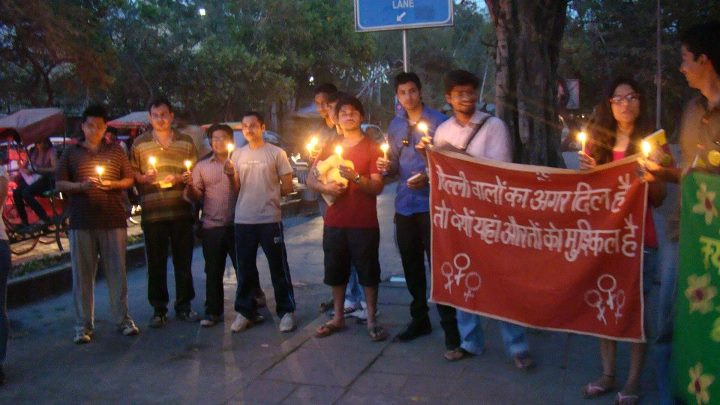Working together for a safe and inclusive city for all
Over the last few years, the issue of women’s safety has gained public attention and concern in Delhi. One does not need to look at the statistics collected by the National Crime Records Bureau to reveal that women in Delhi face high levels of violence. Even a random scan of the daily newspapers is enough to support this. Women in Delhi run the daily risk and fear of harassment, attack, assault, rape and murder, both within their homes and outside.
To address these growing concerns, JAGORI initiated a ‘Safe Delhi Campaign' with the aim of mobilising people in this city to act and make a change. We believe that women and girls have a right to live a life free from violence and fear and that all of us have a role to play in making this a reality. This campaign focuses on strategies to create safer and inclusive environment for all and calls for increased sensitivity towards right to a life of dignity and respect for women and other vulnerable categories in the society.

Click here to see how you can get involved in the campaign
Who is responsible for women’s safety?
Violence against women is not just a ‘women’s issue’. Women's safety and security cannot be ensured only through the efforts of women's organizations. Neither is it merely an issue of law and order. While the police have an important role to play, this is an issue that society has a stake in. After all we don't want police vans at every street corner, in our workplaces, educational institutions etc. There are many sets of actors who have a role to play and this campaign focuses on involving and creating partnerships among women's organizations, NGOs, citizens groups and community organizations, educational institutions, industry, the police and law enforcement agencies, the administration and elected representatives. The conventional approach to women's safety is based on restrictions and fear. Women are told to stay away from places and situations that are potentially violent or to avoid public spaces and stay at home as much as possible, not to go out at night, not to travel alone, not to protest if someone harasses them and so on. This approach makes women alone responsible for their own safety. If something happens to them, it is assumed to have happened because they have not followed the ‘rules’. Moreover, it restricts women's autonomy and curtails their opportunities and participation in the city. It reduces women's self-confidence and makes them physically and psychologically dependent on the protection of others. Ironically, this restrictive approach does not really make women any safer, if anything, it increases their vulnerability by forcing them to live in fear.
While our focus is on women and girls, we recognize that the vulnerabilities of other groups such as children, older people, people with disabilities, migrants also need to be addressed. A "Safe Delhi" should be able to provide a life free of violence and discrimination to all vulnerable groups of people.
Discussions on women's safety must therefore begin from the recognition of women’s right to a life free of violence. From this perspective, the responsibility for preventing violence and making the city safer for women lies with society as a whole, not with women alone. The Safe Delhi Campaign asserts that women have the right to live, to work and to move around with safety and dignity.
What makes cities unsafe?
Many of the factors that make Delhi unsafe for women are common to other cities as well. Some voices in the city collected through street surveys, focus group discussions and other meetings reveal the following one or more factors are reasons that make women in the city vulnerable:
- A poor urban infrastructure – dark or badly lighted streets, derelict parks and empty lots, badly maintained public spaces, inadequate signage, lack of public toilets.
- Empty streets at night because of early closing of shops and businesses or lack of a tradition of street life.
- Lack of adequate public transport and apathy of bus drivers, conductors and passengers.
- Insufficient presence and unresponsive/aggressive attitudes of police and civic authorities.
- Isolation from neighbours and lack of community life.
- Traditional notions of privacy and refusal of neighbours/police to intervene in situations of domestic violence.
- Ideas and beliefs about appropriate behaviour, leading to reluctance to protest in cases of public violence.
- A "macho" culture and a lack of respect for women and women's rights, leading to cases of violence or harassment being ignored or trivialized by the general public as well as those in positions of authority.
What can we do to make cities safe?
We believe that a partnership between women's organizations, NGOs, citizen's groups, the industry, the police and administration as well as other actors in urban governance such as Resident Welfare Associations (RWAs) and elected representatives, all of whom share a common concern for women’s safety can and should play a role in making Delhi safer for women. We need to take stock of the situation in Delhi and identify some concrete and practical actions that can be taken immediately by the Government of Delhi and other actors which will result in making Delhi safer for women. In the longer term, this effort can also be the starting point for building an alliance for following up on the recommendations and monitoring their impact.
Many cities across the world have implemented innovative solutions to these problems. Strategies include community mobilization (such as forming neighbourhood associations), activities for women (such as self-defence training), activities with men (such as campaigns against violence), urban safety planning (such as safe design of public spaces), interventions with police and administration (such as sensitization and training) and activities with the general public (such as safety audits).

